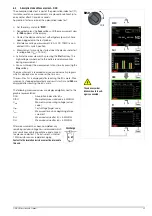
38
GMC-I Messtechnik GmbH
6.14.3 Milliohm Measurement with 200 mA or 20 mA DC [m
]
➭
Make sure that the device under test is voltage-free (see
Chapter 6.6.4). Interference voltages distort measurement re-
sults!
➭
Set the rotary switch to “
m
/4
”.
➭
Select desired test current
Ip set
with the
▲▼
scroll keys.
➭
If applicable, select the desired measuring range using the
Man / Auto
key:
30 m
,
300 m
,
3
(Ip set = +200 mA) or
30
(Ip set = +20mA).
➭
Connect the device under test as shown.
➭
Activate the measurement by pressing the
Start
softkey.
➭
If required, activate thermovoltage correction (see description
below).
➭
Press the
Stop
softkey in order to end the measurement.
KC4 Kelvin clips and KC27 Kelvin probes (available as accesso-
ries) allow for simple, correct connection.
Resistance at the current jacks should amount to
< 5
.
This measuring method is suitable for resistances with induc-
tances of up to 1 H.
Thermovoltage Correction in the 30/300 m
Range
➭
Connect the measurement cables and press the
TComp
soft-
key in order to measure thermovoltage.
Wait until the measured value has settled in. This may take
several seconds, depending upon inductivity. After the mea-
sured value has settled in, press the
Save
softkey. The
TComp
softkey changes color from black to green. All future measure-
ment results will be corrected based upon the previously mea-
sured thermovoltage value.
Thermovoltage can also be measured during a running mea-
surement after pressing the Start softkey.
Use the same procedure as described above.
Measurements at Inductive Devices
Coils, for example in motors, choke ballasts and contactors, are
highly inductive. Changes in current at inductive devices, includ-
ing those caused by switching the milliohmmeter on and off or
changing the measuring range, result in a corresponding voltage
change. These changes may be of significant magnitude, and
may result in arcing under unfavorable conditions. The milliohm-
meter is protected against arcing by means of suitable voltage
arrestors.
6.14.4 Milliohm Measurement with 1 A Pulsating Measuring Cur-
rent (automatic thermovoltage correction at 3
300 m
)
➭
Make sure that the device under test is voltage-free (see
Chapter 6.6.4). Interference voltages distort measurement re-
sults!
➭
Set the rotary switch to “
m
/4
”.
➭
Connect the device under test as shown.
KC4 Kelvin clips and KC27 Kelvin probes (available as accesso-
ries) allow for simple, correct connection.
Resistance at the current jacks should amount to
< 0.5
.
➭
If applicable, select the desired measuring range using the
Man / Auto
key:
3 m
(Ip set = +1A)
, (30 m
or 300 m
(Ip set = +1A)
➭
Connect the device under test as shown.
Thermovoltage is compensated automatically.
➭
Activate the measurement by pressing the
Start
softkey.
➭
Press the
Stop
softkey in order to end the measurement.
The 1 A setting for test current can be protected with a password.
If applicable, you’ll be prompted to enter the valid password.
See also chapter 4.4.6 on page 10, “Changing the Password”,
and chapter 6.1 on page 20, “Enabling Parameter Changes”.
Thermovoltage Correction in the 30/300 m
Range
➭
First of all press the
Start
softkey and then the
TComp
softkey in
order to measure thermovoltage. The
TComp
softkey changes
color from black to green. Wait until the measured value has
settled in. This may take several seconds, depending upon in-
ductivity. All future measurement results will be corrected
based upon the previously measured thermovoltage value.
















































